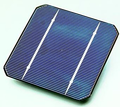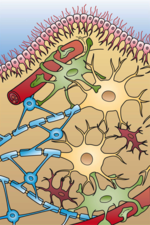Search results
The page "Be made up of cells" does not exist. You can create a draft and submit it for review or request that a redirect be created, but consider checking the search results below to see whether the topic is already covered.
- In biology, cell theory is a scientific theory first formulated in the mid-nineteenth century, that living organisms are made up of cells, that they are...26 KB (3,355 words) - 13:03, 26 April 2024
- Epithelium (redirect from Epithelial cells)appear to be stratified due to the placement of the nuclei. This sort of tissue is called pseudostratified. All glands are made up of epithelial cells. Functions...32 KB (2,885 words) - 04:42, 7 June 2024
- proteins. Cells were discovered by Robert Hooke in 1665, who named them after their resemblance to cells inhabited by Christian monks in a monastery. Cell theory...61 KB (6,320 words) - 00:48, 4 June 2024
- in the battery. Fuel cells can produce electricity continuously for as long as fuel and oxygen are supplied. The first fuel cells were invented by Sir...139 KB (14,403 words) - 03:39, 15 May 2024
- Parenchyma (redirect from Paranchymal cells)the functional tissue in the brain that is made up of the two types of brain cell, neurons and glial cells. It is also known to contain collagen proteins...9 KB (954 words) - 09:45, 23 May 2024
- Some cells are designed to handle sunlight that reaches the Earth's surface, while others are optimized for use in space. Solar cells can be made of a single...148 KB (16,896 words) - 06:58, 19 May 2024
- Sinoatrial node (redirect from Sinoatrial cell)oval shaped region of special cardiac muscle in the upper back wall of the right atrium made up of cells known as pacemaker cells. The sinus node is approximately...24 KB (2,806 words) - 17:50, 24 April 2024
- White blood cells (scientific name leukocytes), also called immune cells or immunocytes, are cells of the immune system that are involved in protecting...32 KB (3,210 words) - 09:17, 4 June 2024
- Lymphocyte (redirect from Lymphoid cells)meaning cell). Lymphocytes make up between 18% and 42% of circulating white blood cells. The three major types of lymphocyte are T cells, B cells and natural...23 KB (2,443 words) - 15:13, 30 May 2024
- Biology (redirect from Index of biology discipline articles)For instance, all organisms are made up of cells that process hereditary information encoded in genes, which can be transmitted to future generations...132 KB (13,750 words) - 12:28, 6 June 2024
- Thin-film solar cells are made by depositing one or more thin layers (thin films or TFs) of photovoltaic material onto a substrate, such as glass, plastic...127 KB (14,316 words) - 08:24, 29 May 2024
- multicellular organisms, stem cells are undifferentiated or partially differentiated cells that can change into various types of cells and proliferate indefinitely...98 KB (11,518 words) - 10:50, 26 May 2024
- in which such cells are conventionally called "electrolytic cells". Furthermore, the term "fuel cell" is usually reserved for cells that produce electricity...12 KB (1,377 words) - 13:49, 8 June 2024
- interior of a cell from the outside environment (the extracellular space). The cell membrane consists of a lipid bilayer, made up of two layers of phospholipids...59 KB (6,906 words) - 21:19, 12 April 2024
- Glia (redirect from Glial cells)Glia, also called glial cells (gliocytes) or neuroglia, are non-neuronal cells in the central nervous system (brain and spinal cord) and the peripheral...38 KB (3,858 words) - 15:38, 7 June 2024
- Thymus (category Wikipedia articles incorporating text from the 20th edition of Gray's Anatomy (1918))thymus is made up of immature T cells called thymocytes, as well as lining cells called epithelial cells which help the thymocytes develop. T cells that successfully...43 KB (5,063 words) - 16:20, 2 May 2024
- Eukaryote (redirect from Eukaryotic cells)81% of the total biomass of Earth. Eukaryotes range in size from single cells to organisms weighing many tons Prokaryotes (small cylindrical cells, bacteria...61 KB (6,038 words) - 11:32, 7 June 2024
- on the cell surface to the T cells of the immune system. They act as messengers between the innate and adaptive immune systems. Dendritic cells are present...34 KB (3,972 words) - 19:54, 25 May 2024
- known as red cells, erythroid cells, and rarely haematids, are the most common type of blood cell and the vertebrate's principal means of delivering oxygen...64 KB (7,844 words) - 22:06, 28 May 2024
- pluripotent stem cells (also known as iPS cells or iPSCs) are a type of pluripotent stem cell that can be generated directly from a somatic cell. The iPSC technology...91 KB (10,491 words) - 07:29, 20 May 2024
- July 1882 (1882) Plant-Cells and their Contents by T. H. McBride 632751Popular Science Monthly Volume 21 July 1882 — Plant-Cells and their Contents1882T
- Tom Clancy's Splinter Cell (2002) is the first game in the Splinter Cell series of books and video games. Released in late 2002, the game follows NSA agent
- systems—lack cells or basic cell structure. All plants, including very simple plants called algae, and all animals are made up of cells, and these are



















